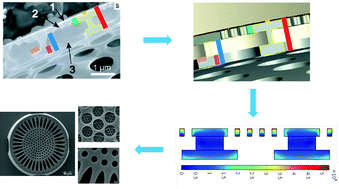当前位置:
X-MOL 学术
›
Biomater. Sci.
›
论文详情
Our official English website, www.x-mol.net, welcomes your feedback! (Note: you will need to create a separate account there.)
The role of hierarchical design and morphology in the mechanical response of diatom-inspired structures via simulation
Biomaterials Science ( IF 6.6 ) Pub Date : 2017-11-06 00:00:00 , DOI: 10.1039/c7bm00649g Alejandro Gutiérrez 1, 2, 3, 4, 5 , Metin G. Guney 5, 6, 7, 8 , Gary K. Fedder 5, 6, 7, 8, 9 , Lilian P. Dávila 1, 2, 3, 4, 5
Biomaterials Science ( IF 6.6 ) Pub Date : 2017-11-06 00:00:00 , DOI: 10.1039/c7bm00649g Alejandro Gutiérrez 1, 2, 3, 4, 5 , Metin G. Guney 5, 6, 7, 8 , Gary K. Fedder 5, 6, 7, 8, 9 , Lilian P. Dávila 1, 2, 3, 4, 5
Affiliation

|
Diatoms are microscopic algae with intricate shell morphologies and features ranging from the nanometer to the micrometer scale, which have been proposed as templates for drug delivery carriers, optical devices, and metamaterials design. Several studies have found that diatom shells show unique mechanical properties such as high specific strength and resilience. One hypothesis is that these properties stem from the structural arrangement of the material at the nanometer and micrometer length scales, challenging the concept between what constitutes a “material” versus a “structure”. In this work, we have conducted a systematic simulation-prototyping study to shed light on the mechanics of diatom-inspired hierarchical microstructures. The Finite Element Method (FEM) was used to replicate three-dimensional diatom shells under compressive forces. The intricate hierarchical shell structure of the Coscinodiscus sp. diatom frustule observed in nature was reproduced in detail. Simulation parameters were selected to reproduce compression experiments, with a force distributed on the surface of the diatom shell. A frustule diameter of 50 μm was used with pore diameters ranging from 0.25 to 1.2 μm across different layers. A “unit cell” FEM model was also created to focus on the basic structural element of a diatom frustule. Both of these models were used to elucidate the relation between morphology and mechanical response. Additionally, select designs were prototyped using 3D Direct Laser Writing (DLW) lithography to evaluate the feasibility of manufacturing diatom-inspired devices at the micro-scale. Distinct correlations between pore size in each frustule layer, or pore shape in the basal layers, and the mechanical response of the diatom shell were established in this study. The 3D-DLW prototypes exhibit a similar level of intricate morphological traits observed in real diatoms, opening the possibility of a simulation-based process for the design and fabrication of diatom-inspired microdevices. This research helps explain how morphology features are central to the mechanical performance of hierarchically arranged structures and biomaterials in general, and it represents a step toward the manufacture of emerging metamaterials and microarchitectures.
中文翻译:

通过仿真,分层设计和形态在硅藻启发的结构的机械响应中的作用
硅藻是具有复杂外壳形态和特征(从纳米到微米级)的微观藻类,已被提出作为药物输送载体,光学装置和超材料设计的模板。多项研究发现硅藻壳具有独特的机械性能,例如高比强度和回弹力。一种假设是,这些特性源自材料在纳米和微米长度尺度上的结构排列,从而挑战了“材料”与“材料”之间的关系。一个“结构”。在这项工作中,我们进行了系统的仿真原型研究,以阐明硅藻启发的分层微观结构的力学。有限元方法(FEM)用于在压力下复制三维硅藻壳。Coscinodiscus的复杂的分层外壳结构sp。详细观察了自然界中观察到的硅藻壳。选择模拟参数以重现压缩实验,力分布在硅藻壳的表面。截头直径为50μm,跨不同层的孔径范围为0.25至1.2μm。还创建了一个“晶胞” FEM模型,以关注硅藻壳的基本结构元素。这两个模型都用于阐明形态与机械响应之间的关系。此外,使用3D直接激光写入(DLW)光刻技术对选定的设计进行原型设计,以评估在微型规模上制造硅藻启发的设备的可行性。每个壳层的孔径或基础层的孔径形状之间存在明显的相关性,本研究建立了硅藻壳的力学响应。3D-DLW原型在真实的硅藻中表现出相似水平的复杂形态特征,这为硅藻启发的微器件的设计和制造提供了基于仿真过程的可能性。这项研究有助于解释形态特征在总体上如何对分层排列的结构和生物材料的机械性能至关重要,并且代表了制造新兴的超材料和微体系结构的一步。
更新日期:2017-11-17
中文翻译:

通过仿真,分层设计和形态在硅藻启发的结构的机械响应中的作用
硅藻是具有复杂外壳形态和特征(从纳米到微米级)的微观藻类,已被提出作为药物输送载体,光学装置和超材料设计的模板。多项研究发现硅藻壳具有独特的机械性能,例如高比强度和回弹力。一种假设是,这些特性源自材料在纳米和微米长度尺度上的结构排列,从而挑战了“材料”与“材料”之间的关系。一个“结构”。在这项工作中,我们进行了系统的仿真原型研究,以阐明硅藻启发的分层微观结构的力学。有限元方法(FEM)用于在压力下复制三维硅藻壳。Coscinodiscus的复杂的分层外壳结构sp。详细观察了自然界中观察到的硅藻壳。选择模拟参数以重现压缩实验,力分布在硅藻壳的表面。截头直径为50μm,跨不同层的孔径范围为0.25至1.2μm。还创建了一个“晶胞” FEM模型,以关注硅藻壳的基本结构元素。这两个模型都用于阐明形态与机械响应之间的关系。此外,使用3D直接激光写入(DLW)光刻技术对选定的设计进行原型设计,以评估在微型规模上制造硅藻启发的设备的可行性。每个壳层的孔径或基础层的孔径形状之间存在明显的相关性,本研究建立了硅藻壳的力学响应。3D-DLW原型在真实的硅藻中表现出相似水平的复杂形态特征,这为硅藻启发的微器件的设计和制造提供了基于仿真过程的可能性。这项研究有助于解释形态特征在总体上如何对分层排列的结构和生物材料的机械性能至关重要,并且代表了制造新兴的超材料和微体系结构的一步。



























 京公网安备 11010802027423号
京公网安备 11010802027423号